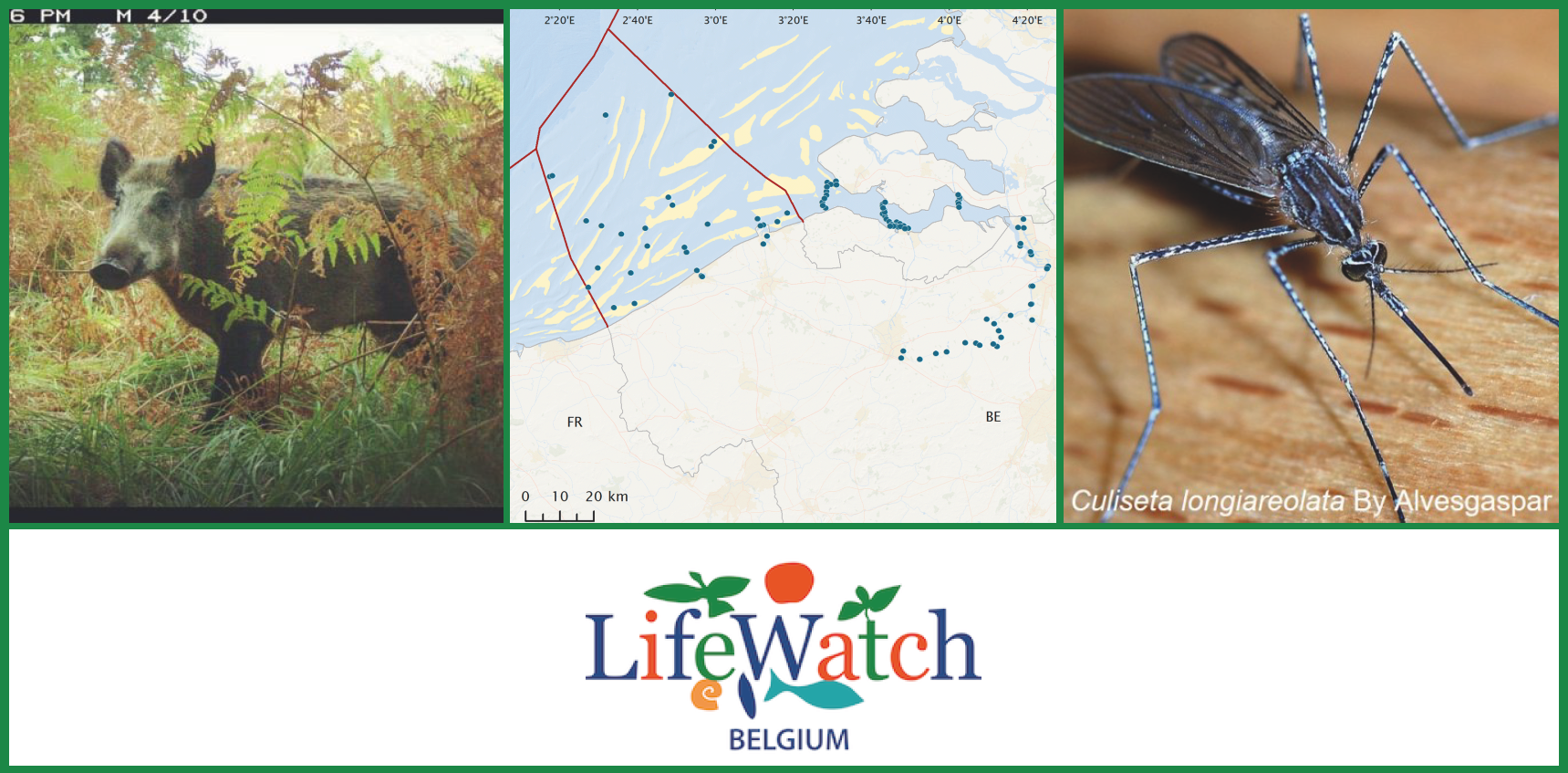
There’s been a lot going on at LifeWatch Belgium recently, so please flick through some of our favourite news stories from the LifeWatch Belgium website, where you can find the full versions of these featured articles. Source images: CATREIN, PBARN & Alvesgaspar.
PhD research reveals wild boar behaviour
Jolien Wevers successfully defended her PhD research on wild boar and roe deer ecology in a human-dominated landscape at Hasselt University
Jolien used the LifeWatch camera trap infrastructure (CATREIN) to investigate how wild boar and roe deer cope with human disturbance in a strongly urbanised environment at different temporal and geographical scales, and at different levels of intensity of human disturbance. 40 cameras registered wildlife presence and behaviour in the National Park Hoge Kempen in a collaborative effort between Hasselt University, INBO and LifeWatch Flanders. 4 years and millions of images later, the PhD research is finished.
The findings of the doctoral thesis implicate that at large scales the space use of both wild boar and roe deer is mainly driven by environmental variables (such as forest availability) rather than being driven by human activities. At smaller scales and high anthropogenic disturbance levels, wild boar display clever and opportunistic behaviour and avoid human contact by adapting their time use. At sunset, they are active in quiet areas without disturbance. Areas with many hiking trails or where hunting is allowed are only visited in the middle of the night. Roe deer on the other hand, do not actively avoid areas with human disturbance, but they do adjust their activity pattern. Instead of being very active at dawn and dusk, they are more active at night.
Publications:
- Wevers, J.; Fattebert, J.; Casaer, J.; Artois, T.; Beenaerts, N. (2020) Trading fear for food in the Anthropocene: How ungulates cope with human disturbance in a multi-use, suburban ecosystem, Science of The Total Environment, vol. 741, 1 November 2020, 140369
- Wevers, J.; Beenaerts,N.; Casaer, J.; Zimmermann, F.; Artois, T.; Fattebert, J. (2021) Modelling species distribution from camera trap by-catch using a scale-optimized occupancy approach, Remote Sensing in Ecology and Conservation
Contact persons:
UHasselt : Natalie.Beenaerts@uhasselt.be
INBO : jim.casaer@inbo.be
Big Five conservation measures for diadromous fish
Five years of fish tracking research using the LifeWatch fish acoustic receiver network has generated key insights into how to save diadromous fish species from historic decline
Population numbers of diadromous fish species have reached an all-time low. Diadromous fish migrate between the sea and rivers to complete their lifecycle, such as salmon, which spawn in rivers, but grow at sea. Or eels, which do the exact opposite. However, due to water regulating obstacles in rivers like dams and hydropower stations, their migration is blocked. On top of that, many rivers have been degraded substantially by human activities, leading to the disappearance of essential spawning and growing habitats.
Researchers from Ghent University (UGent), Flanders Marine Institute (VLIZ) and the Research Institute for Nature and Forest (INBO) have come up with five actions (the ‘Big Five’) to restore diadromous fish populations:
- Check the functionality of a migration barrier and whether it can be removed
- Adjust the barrier to allow for the passage of fish, both upstream and downstream
- Restore spawning and growing habitats to a good state to permit species recolonisation
- Restock juvenile fish from nearby populations in the event of the complete eradication of source populations
- Ensure sustainable fishing is carried out on relevant species only once their populations are fully restored
You can read the whole article here.
For more information on the difficult migration of the eel, a diadromous species:
First Detections of Culiseta longiareolata (Diptera: Culicidae) in Belgium and the Netherlands
Between 2017 and 2020, Culiseta longiareolata specimens were found at distinct locations in Belgium and the Netherlands – a potential vector of bird pathogens
Collected mosquitoes were morphologically identified and the identification was then validated by LifeWatch BopCo using COI DNA barcoding. These are the first records for this species, which might be a potential vector of bird pathogens (e.g., West Nile virus), in Belgium and the Netherlands. More information on the mosquito monitoring project, during which the Cs. longiareolata specimens were collected, can be found on the MEMO project page.
The Barcoding Facility for Organisms and Tissues of Policy Concern (BopCo) is financed by the Belgian Science Policy Office (Belspo) as Belgian federal in-kind contribution to LifeWatch ERIC.
Publication: